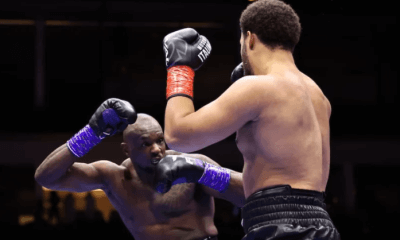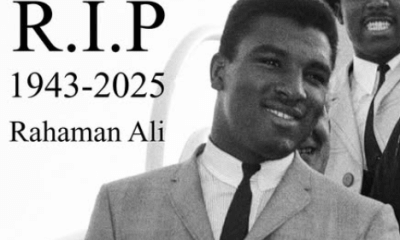Featured Articles
Monster Indeed: Naoya Inoue Destroys Payano in Japan
Juan Carlos Payano was ranked the fifth best bantamweight in the world by the TBRB going into today’s fight with Naoya Inoue and would have been ranked

Juan Carlos Payano was ranked the fifth best bantamweight in the world by the TBRB going into today’s fight with Naoya Inoue and would have been ranked higher were it not for his desperately close loss in his 2016 rematch with Rau’shee Warren. Payano had beaten Warren the year before and in dropping the razor-thin majority call in the rematch he had posted the only loss of his career.
Until today when he met Naoya and was blasted out in a single round in Yokohama, Japan.
A career bantam, Payano has a mixture of rugged determination, elegant movement, elite workrate and experience that was supposed to present a genuine threat to the Japanese. Most of all, his proven punch resistance, heralded by appearances at the Olympics in 2004 and 2008 and by a 20-1 professional ledger that bore no stoppage losses, was supposed to represent a real test for Naoya’s punching power in his new bantamweight home.
True, Naoya had done away with the enormous Jamie McDonnell in just a round but there were mutterings about the Englishman’s suffering in making the weight. Where Payano was concerned, there were no such issues.
In mere seconds, Naoya destroyed Payano completely, knocked him into what amounted to unconsciousness and sent out a second consecutive warning to the 118lb division and to boxing at large. This contest, which was a quarter-final to the excellent WBSS bantamweight tournament, puts not just the other competitors on warning but to the likes of Vasyl Lomachenko and Terence Crawford. Naoya already holds straps in three divisions and at twenty-five years old and having fought just seventeen contests, there is a more to come. The best fighter in the world may now be Japanese for the first time in history (remembering that the legendary Fighting Harada shared his prime with a peak Muhammad Ali).
The pathology of his violence is exquisite. At bell he walked into Payano’s range and did nothing, then stepped just out of range; and back in. Payano was tempted, throwing a jab to the body and Naoya had now measured his guns. Left extended in a queer nodding motion, he shifted precisely nowhere in a deep stance that declares his intention while throwing none of the punches it promises. He is a watching, waiting, learning doom-machine that appears to have been programmed by Carlos Zarate.
Naoya circled with Payano, but maintained that eerie distance that allowed him to dip in and out of his opponent’s sphere of influence – and, by extension, drop Payano in and out of his own.
Payano is no stranger to strategy, to timing, to dueling for the range. He was an amateur of enormous experience and holds a win as a professional over the excellent Anselmo Moreno. He kept his left hand high, feinted with the southpaw jab, tried to buy a trailing lead to the body; normal fight stuff, the stuff that works to gain ground on mortals. Naoya skipped away from the lead, moving almost before it was thrown and at safe distance by the time Payano was trying to re-gather himself. Now Naoya had measured Payano’s over-extension.
Muscled and full-fleshed rather than the drawn fighter we saw at 108lbs, Naoya’s movement looks like that of a fighter who has found his home. Another division is almost certainly on the cards, a fifth far from impossible, but I suspect bantamweight is the division where we will see the best of him. Like Ruben Olivares, he is fast enough and hits hard enough to devastate top men in bigger weight classes, but here he is capable of the type of immolation that makes legends.
And this the thing that will stay most with me of the punches that separated Payano from his senses with two minutes of the first round remaining: they didn’t look that hard.
Like Zarate, who threw punches with the nonchalance of a drunk emptying ashtrays into his back yard, yet sent fighters broken and reeling, Naoya stuck out a sharp jab and in a fraction of a second, in the blinking of an eye, landed the right hand that accompanied it on the same spot. Like he had had his bones scooped from his body, Payano shrugged his shoulders and fell down and into himself, stiffened on the canvas, propped himself up on his elbows and then rolled over onto his side as though reclaiming sleep from an alarm clock as the messages of disaster rattled through his body.
Naoya, who knew immediately that he was victorious, pounded his gloves together and then raised his right fist to the roof of the Yokohama Arena. He literally had not broken a sweat. Besides the anxious wait to see that Payano was unhurt (he was), his evening was over.
In this article I have compared Naoya Inoue to Fighting Harada, Carlos Zarate and Ruben Olivares. I’m quite comfortable with that.
A poisoned bullet atop a stacked card from Japan, Naoya had thrown the best punch of the day but there were others of note. Ken Shiro, the best light-flyweight in the world and also Japanese, made short work of that divisional #5 contender, Milan Melindo. Shiro, now 14-0, brutally broke down his Filipino opponent with straight, two-handed fuselages of punches which disintegrated Melindo’s face with alarming rapidity. Cut, battered, vulnerable to the body while he desperately tried to protect his crumbling face, Melindo probably never stopped trying but when he was rescued by the ringside doctor during the seventh, there were no complaints.
Shiro, who is head and shoulders above the competition at 108lbs, may be the next pound-for-pound rated Japanese superstar.
Also on the undercard and a part of yet another WBSS tournament, this time at 140lbs, was a meeting between ranked light-welterweights Kiryl Relikh and Eduard Troyanovsky. Relikh advanced to the next round with a close, well-earned and unanimous points decision.
Check out more boxing news on video at The Boxing Channel
To comment on this article at The Fight Forum, CLICK HERE.
-

 Featured Articles4 weeks ago
Featured Articles4 weeks agoThe Hauser Report: Zayas-Garcia, Pacquiao, Usyk, and the NYSAC
-

 Featured Articles3 weeks ago
Featured Articles3 weeks agoOscar Duarte and Regis Prograis Prevail on an Action-Packed Fight Card in Chicago
-

 Featured Articles2 weeks ago
Featured Articles2 weeks agoThe Hauser Report: Cinematic and Literary Notes
-

 Book Review2 weeks ago
Book Review2 weeks agoMark Kriegel’s New Book About Mike Tyson is a Must-Read
-

 Featured Articles4 weeks ago
Featured Articles4 weeks agoRemembering Dwight Muhammad Qawi (1953-2025) and his Triumphant Return to Prison
-

 Featured Articles1 week ago
Featured Articles1 week agoMoses Itauma Continues his Rapid Rise; Steamrolls Dillian Whyte in Riyadh
-

 Featured Articles3 days ago
Featured Articles3 days agoThe Hauser Report: Debunking Two Myths and Other Notes
-

 Featured Articles3 weeks ago
Featured Articles3 weeks agoRahaman Ali (1943-2025)


















